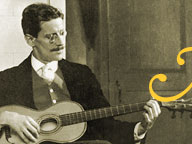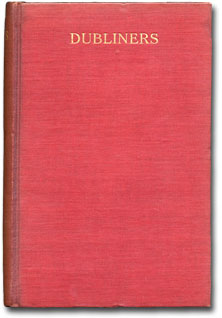

| Works: | Poetry | Dubliners | A Portrait | Exiles | Ulysses | Finnegans Wake |
 |
 |
|
Music in Dubliners
Compared to his later works, music in this collection of short stories by James Joyce plays a relatively peripheral role in the action of the narratives. But even here the reader can see in embryonic form the technique that Joyce was to develop later on of introducing certain, deliberately chosen songs integrally into his fiction, using the music to advance or comment on the dramatic action. In Dubliners, this device is used to particularly good effect in the final story, "The Dead." Though quoted in part as Mr. D'Arcy sings it, the exact version of the ballad The Lass of Aughrim, which figures so prominently in that story, has so far eluded Joycean scholars. However, three songs alluded to in various stories in the collection are performed on the Vol. II CD, MORE Music from the Works of James Joyce, namely:
An additional four songs mentioned in the collection can be heard on our first volume of Joycean music: Silent, O MoyleThis song appears in "Two Gallants," a short story in Joyce's Dubliners (and also, later, in Ulysses). In the short story, this Thomas Moore melody is played on the harp by a street musician who attempts to coax money out of passersby, appealing to their Irish sentiments. The musician's harp, with its semi-nude female figure carved on the front, is clearly the symbol of a degraded Ireland. As the musician idly plucks the melody of the song, which expresses the wish that Erin, still sleeping in darkness, be warmed with the day star of peace and love, the image is one of Ireland betrayed and prostituted.
The Ulysses allusion is made by Stephen Dedalus, who compares "Lir's loneliest daughter" with Cordelia, the daughter of Shakespeare's King Lear. Both are exiles, with the Irish Lir's daughter Fionnuala doomed to wander in the form of a swan over certain lakes and rivers in Ireland, until the coming of Christianity and the sounding of the first Mass bell was to signal her release. I Dreamt That I Dwelt in Marble Halls
Long a favorite performance piece, even to this day (it is featured on a recent recording by Enya), this is Maria's song to Joe and his family in the Dubliners story "Clay." Maria, a spinster who once nursed Joe and his brother Alphy when they were younger, touches the grown man with her rendition — in which, as Joyce is careful to point out, she leaves out the second stanza. That stanza involves suitors and a bridegroom. Whether Maria's omission is inadvertent, or is done consciously merely to save herself embarrassment, we can only conjecture. The song does serve to link the elderly spinster with the young Eveline from the story of the same name: Eveline is about to cast away a prospective marriage with Frank in favor of a life of single drudgery in Dublin. Frank does escort Eveline to an operetta, Balfe's Bohemian Girl, from which Maria's song is taken. (This is one of the many ways that Joyce links the stories in Dubliners.) I'll Sing Thee Songs of Araby
This piece may very well have been the inspiration for Joyce's short story "Araby," which is part of Dubliners. Indeed, the story does refer to an actual fair that took place in Dublin in May 1894. But Joyce did know and utilize the song of the same name in Finnegans Wake, and its lyrics completely fit the courtly love motif upon which the short story is based. At the end of the story, the adolescent protagonist finds himself in a darkened hall with all his dreams of Araby and Eastern enchantment dashed. Yes! Let Me Like a Soldier Fall
This piece is referred to in "The Dead," the last story of Dubliners, whose Mr. Browne introduces the subject of an Italian tenor of bygone years who had once sung five encores to this song, "introducing a high C every time." It is part of a continuing pattern of references to past events and deceased people throughout the story, especially to singers of long ago who (in the opinion of the company) far surpassed the vocalists contemporary to the time of the story. The introduction of the high C would probably have come at the end of Don Caesar's aria via a gratuitous alteration of the music to please the audience through a transposing of the last two notes of the song up an octave, since the original score calls only for a middle C. Nevertheless, the song is a part of the death metaphor that runs throughout the story.
|
 Albany, New York :: Boston, Mass. :: Essen, Germany
Albany, New York :: Boston, Mass. :: Essen, Germany
|